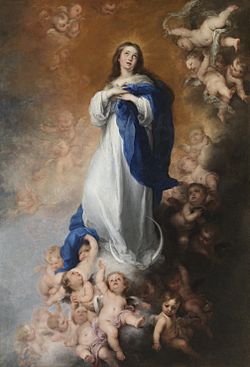The Immaculate Conception of Los Venerables facts for kids
Quick facts for kids The Immaculate Conception of Los Venerables |
|
|---|---|
| Spanish: La Inmaculada Concepción de los Venerables | |
 |
|
| Artist | Bartolomé Esteban Murillo |
| Year | c. 1678 |
| Medium | Oil on canvas |
| Dimensions | 274 cm × 190 cm (108 in × 75 in) |
| Location | Museo del Prado, Madrid, Spain |
The Immaculate Conception of Los Venerables is a famous oil painting by the Spanish artist Bartolomé Esteban Murillo. It is also known as The Immaculate Conception of Soult. Murillo painted it around 1678. The painting is quite large, measuring about 274 by 190 centimeters.
This artwork has a long history. It was taken from Spain in 1813 during a war. Later, it was bought by the Louvre Museum in France. Since 1941, it has been kept at the Museo del Prado in Madrid, Spain.
Contents
The Painting's Journey and Owners
This section tells you about the history of the painting. It explains who owned it and where it traveled over the years.
How the Painting Was Made
A man named Justino de Neve asked Bartolomé Esteban Murillo to paint this artwork. Justino de Neve was an important church leader in Seville, Spain. He wanted the painting for his own art collection. Later, in 1686, he gave it to a hospital chapel in Seville called the Hospital de los Venerables.
Belief in the Immaculate Conception
In Spain, people strongly believed in the Immaculate Conception since the 1500s. This belief is about Mary, the mother of Jesus, being pure from the moment she was born. Spain was a big supporter of this idea. They even worked hard for it to become an official teaching of the Catholic Church. This finally happened in 1854. Because of this strong belief, the Immaculate Conception became a very important symbol in art during that time. Many artists, like Murillo, painted it.
The Painting Is Taken to France
In 1813, during a war called the Peninsular War, the painting was taken from Spain. A French military leader, Marshal Jean-de-Dieu Soult, took it to France. The painting's original frame was left behind in the hospital in Seville. The painting stayed with Soult until he died in 1851. This is why it is sometimes called The Immaculate Conception of Soult.
Returning to Spain
After Soult died, the painting was sold in 1852. The Louvre Museum in Paris bought it for a very high price. It was said to be the most money ever paid for a painting at that time. The painting was shown at the Louvre until 1941.
During World War II, a French government called the Vichy Regime agreed to send the painting back to Spain. This was part of an art exchange with Spain's leader, Francisco Franco. Spain also received other important artworks, like the Lady of Elche. In return, Spain's Museo del Prado gave the Louvre a painting by Diego Velázquez called Portrait of Mariana of Austria.
In 1981, experts at the Prado Museum carefully cleaned the painting. A more detailed cleaning and repair was done in 2007.
What the Painting Shows
Murillo painted many versions of the Immaculate Conception. He might have painted more than any other Spanish artist.
Mary's Appearance
In most of Murillo's paintings, Mary wears a white robe and a blue cloak. Her hands are crossed over her chest. A crescent moon is at her feet, and her eyes look up towards Heaven. She stands in a way that makes her look like she is moving. Her right knee is bent, and her weight is on her left leg. This creates a flowing look in the painting. A thin crescent moon is placed at an angle around her foot. Her foot is hidden by her clothes, which was considered polite.
A Triumphant Feeling
The Immaculate Conception of Los Venerables is special because it feels very joyful and victorious. Murillo used light in a clever way to create this feeling. The light makes your eyes move from the bottom right of the painting to the top left. This upward movement, along with the clouds and angels around Mary, makes you think of the Assumption. The Assumption is the belief that Mary was taken up to Heaven. This painting connects Mary's purity with her role as Christ's mother.
Missing Symbols
In this painting, Murillo did not include some symbols that were often seen in art of the Virgin Mary. These include things like the Tower of David or a sealed garden. This might be because these symbols were already on the painting's original frame at the Los Venerables Hospital.
See also
 In Spanish: Inmaculada de Soult para niños
In Spanish: Inmaculada de Soult para niños

